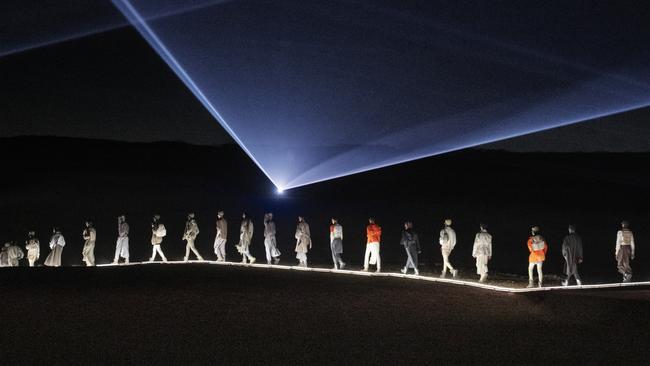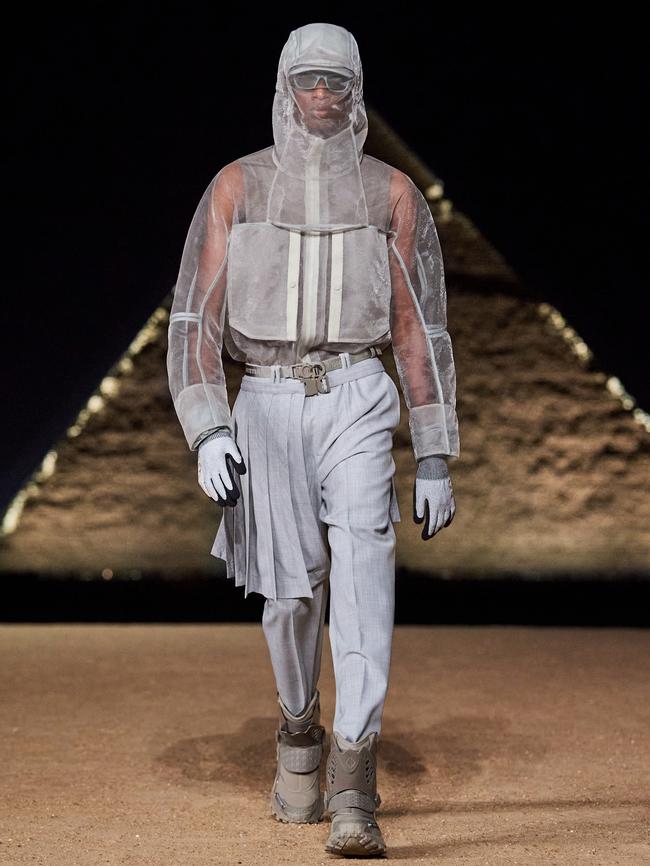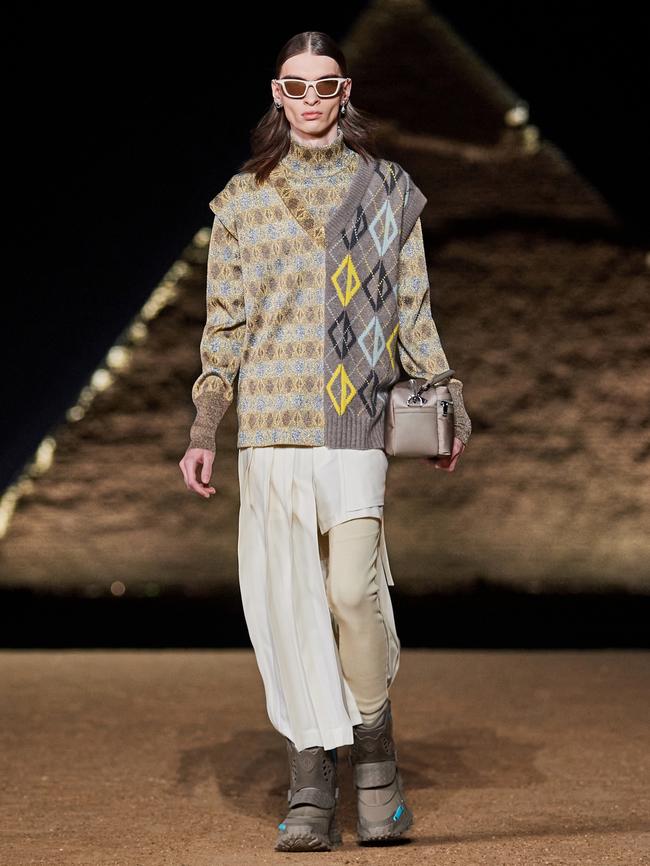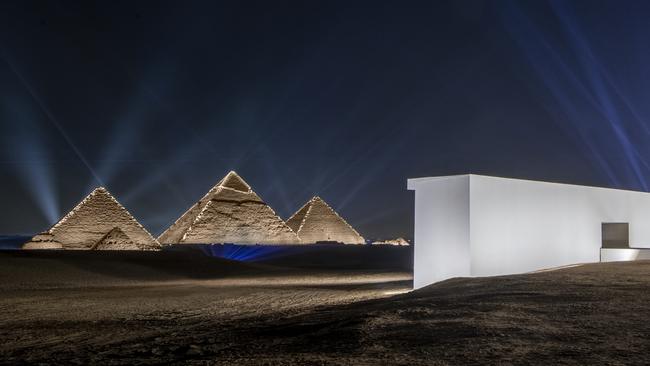Any notion that luxury brands would pull back on lavish fashion shows at exotic locations – the sort that cost millions of dollars to stage and require a small army to orchestrate – in a post-pandemic economy was well and truly debunked late last year when Dior staged a men’s collection show at the pyramids of Giza in Egypt. The event, which was attended by celebrities including Lewis Hamilton, Robert Pattinson and Naomi Campbell, was the first fashion show to be held at the pyramids and, as such, a major coup for Dior. The show was also designed to mark the 75th anniversary of the establishment of Christian Dior’s business in 1947, so 75 looks were shown on the desert runway – 50 per cent more than at a regular Dior fashion show. As the artistic director of Dior Men, Kim Jones, told WISH before the show, “people have travelled a long way for this; we ought to give them something special”.
-
Discover the world’s best fashion, design, architecture, food and travel in the March issue of WISH magazine.
-
Pre-pandemic, brands such as Dior, Louis Vuitton, Chanel and Gucci attempted to outshine one another by staging collection shows away from their traditional home turf of Paris and Milan. The strategy was in keeping with the increasingly global outlook of the brands, which started life with a one or two stores in their European city of origin, but in the late 20th century underwent a rapid expansion with stores all over the world. The brands are selling their particular style of French or Italian (and in some cases Spanish or British) savoir faire to customers in their home cities, so staging their biggest events in locations other than Paris and Milan made good business sense. It also helped to add some excitement to the collection shows. Where will they go next?
Where they went in the Covid-19 pandemic was nowhere. Restrictions on travel and crowd-gathering scuttled destination shows, but they came roaring back mid last year when Chanel headed to Monaco and Dior to Seville for its women’s collection, Gucci showed in Puglia and Louis Vuitton went to San Diego. Then the week after the Dior show in Egypt, Chanel showed its Métiers d’art collection at Dakar in Senegal.

Shortly after the Cairo show, Dior’s then chief executive, Pietro Beccari, confirmed that the company had no plans to wind back on staging destination fashion shows. “The essence of the house of Dior, from the very beginning, has been to make people dream. So yes, the dream continues of course, and the next destination [shows] will promise incredible experiences combining magic, creativity and surprise,” he told WISH.
Earlier this year Beccari was promoted to chairman and chief executive of Louis Vuitton, the biggest brand in the LVMH stable. Delphine Arnault, daughter of LVMH chairman Bernard Arnault, assumed the role of chief executive of Dior in February.
With its fall 2023 men’s show at the pyramids, however, Dior raised the stakes to an otherworldly level when it comes to destination fashion shows. Jones, the British designer who is the artistic director of Dior Men as well as Fendi’s women’s collection, told WISH before the show that the inspiration for the collection was focused on the sky more than Egypt itself.
“Christian Dior was obsessed with astrology and the [ancient] Egyptians were obsessed with astronomy, and I liked that association,” he said. “My interest in ancient Egypt is about the stars and the sky. I looked at the design of the collection as a sci-fi spacey thing rather than an Egyptian thing.” The concept for the lighting of the pyramids was inspired by a drawing Jones has by the artist and filmmaker Derek Jarman.


The collection featured earthy tones and desert colours on clothes that had a distinctly utilitarian style. Contemporary techniques and textures, from high-frequency neoprene panelling and injection moulding to anodised metal finishes were combined with more traditional fabrications. As the show started and the models rose from beneath the catwalk, which traversed the length of the pyramids, before disappearing out of sight as though they were heading underground, the colour palette of the garments shifted from greys to desert colours, with flashy bursts of fiery sunset hues of yellow and orange.
Jones has had a connection with the African continent since he was a child. As the son of a hydrogeologist, he spent his teenage years in living in Kenya, Tanzania, Ethiopia and Botswana. He has also visited Egypt several times for holidays, the most recent being a cruise down the Nile in 2019 with his close friend, model Kate Moss. “It was a beautiful experience,” he says. “The minute you get outside Cairo the towns don’t really get over a million people so it’s easy to get around. The Valley of the Kings is beautiful, the Valley of the Queens is amazing, and even when you’re just going down the Nile there’s all the papyrus along the side of the river and farmland everywhere and it looks the way it must have looked thousands of years ago.”
It was actually Beccari who suggested the country as a location for a fashion show. “Dior has strong and unwavering cultural ties with Egypt since its founding and first collection in 1947,” he says. Some of Christian Dior’s haute couture dresses bore names such as Cairo, Egypt, Cleopatra and Ramses. Dior himself travelled to Egypt in 1956, and in 2004 then artistic director John Galliano designed a collection in tribute to Ancient Egypt after a hot-air balloon tour over the country. “The choice of this destination therefore seemed perfectly natural in light of our unique heritage,” says Beccari.
Egypt, however, was more than just a picturesque setting for the men’s collection. “The backdrops, as sumptuous as they are, are never only backdrops for us – on the contrary,” says Beccari. “For this show we worked with local teams and committed organisations to create positive circles on an ethical, social and economic level, as well as ecologically. We also donated several elements of the show to Egyptian associations.”
A group of Egyptian artisans also produced items for the collection itself. Some of the bags were made by basket weavers in Egypt, as were some blankets. According to Jones, more than 1000 local people were employed on the collection. “We wanted it to be something that benefits people and is not just us going in with all our people and then leaving,” he said.
-
“The essence of the house of Dior, from the very beginning, has been to make people dream.”
-
With spectacular destination shows, fashion brands haven’t just been attempting to outdo each other, they have also built a rod for their own backs. The expectation from fashion watchers is for a venue and set that is bigger, better and more exotic each season. Jones, however, says he doesn’t feel that pressure personally. “I always reset every couple of years with what we do,” he says.
For Dior’s 2023-2024 winter collection, shown in Paris in January, the scenography was inspired by the Thames and the Seine rivers in London and Paris respectively, and T.S Eliot’s poem The Waste Land. The models walked on a set flanked by a giant screen to a live performance by Max Richter, who recomposed Vivaldi’s The Four Seasons for the Egypt show. The Paris show unfolded at a deliberately slower pace than the one at the pyramids and, says Jones, “it was a very personal thing. Resetting each season with what we do helps keep customers interested. [The January show felt] quite intimate and very emotional for me. It’s taking it back to a different way of working.” But, he says, when you stage a show in front of the pyramids, you need big gestures and big silhouettes.


Add your comment to this story
To join the conversation, please log in. Don't have an account? Register
Join the conversation, you are commenting as Logout